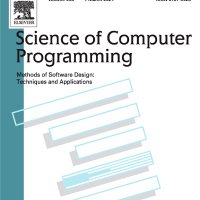
SCICO
@scico_journal
Science of Computer Programming is dedicated to the distribution of research results in the areas of software systems development, use and maintenance.
ID: 1353278896859471872
https://www.journals.elsevier.com/science-of-computer-programming 24-01-2021 09:50:21
323 Tweet
254 Followers
46 Following


Liu et al. introduce an optimized Farkas' Lemma-based invariant generation method using divide-and-conquer and pruning to reduce CNF-to-DNF conversion overhead. It achieved a 9.27x speedup over existing methods with the same accuracy on a custom dataset. authors.elsevier.com/a/1lRvnc7X5EoCj


Zili et al. introduce WEST, an interactive visualization tool to help practitioners validate Mission-time Linear Temporal Logic (MLTL). The evaluation includes 5 validation methods and scalability tests with 3 suites of randomly generated MLTL formulas. authors.elsevier.com/a/1lSM5c7X5EoDI





Rabbiun et al. introduce an exact schedulability test for Adaptive Mixed-Criticality systems with Weakly-Hard constraints using a generalized (m,k)-firm model. The evaluation shows an 18% schedulability improvement over the traditional skip-over model. authors.elsevier.com/a/1lbEtc7X5EoFy




Gómez Llanez et al. employ four design patterns in a Cognitive-Affective model to simplify serious game development. Evaluation through case studies, usability tests, and statistical analysis showed less development times w/o affecting training quality. authors.elsevier.com/a/1ldzSc7X5EoFI

Gholami et al. introduce a Case-Based Reasoning method using Repertory Grid Technique features to help software architects select patterns that meet specific quality requirements. The method achieved 83% accuracy in predicting the most suitable pattern. authors.elsevier.com/a/1lfpQc7X5EoG8



Salimi et al. introduce a profit-aware, adaptive scheduling algorithm for heterogeneous multi-server CPS to meet deadlines and maximize system profit. Simulations show that it outperforms baseline methods in response time, profit, and deadline adherence. authors.elsevier.com/a/1lnm2c7X5EoHH


Duong et al. introduce an interactive dashboard for peer code review in a programming course. It was evaluated over a 17-week experiment, comparing dashboard users to a control group, showing improved engagement, performance, and instructor monitoring. authors.elsevier.com/a/1lv7kc7X5EoHx
